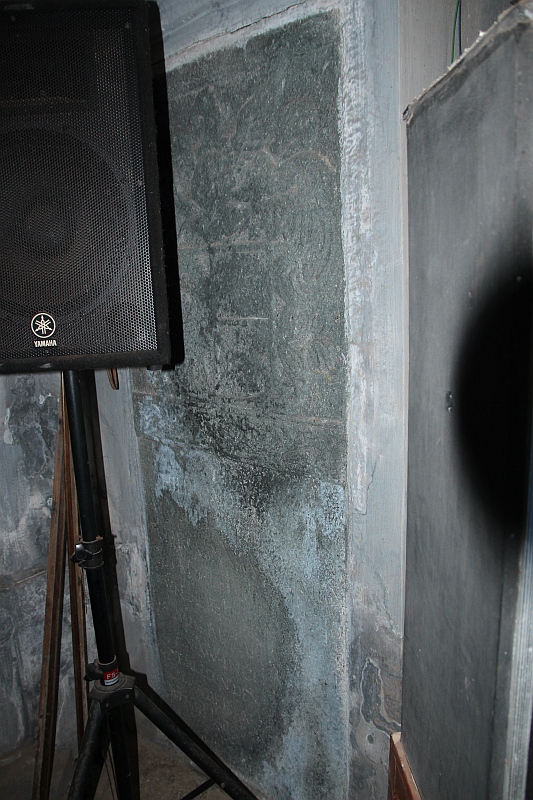Fort Kochi - Adriaan van Ommen
A drawing was made of the tombstone of Adriaan van Ommen at the end of the 19th century. At that time, the stone was already in a poor condition, and is still now. The stone must have been commissioned by someone who knew a thing or two about him and cared enough about him to spend so much money. The stone was decorated with a family coat of arms and mentions Adriaan's age, indicated in days, months, and years. The date of death is carved out as 27th November 1696.[i] The engraver of the stone left his age somewhat blurry, so that it remains guesswork what it said. Only the 38 years have clearly been copied and once 2 months and 5 days were added. His date of birth should then be around 22 or 23 of September 1658. The baptism date is usually within 6 weeks thereafter, with exceptions.
 Tombstone of Adriaan van Ommen, in the wall of the church (photo Leon Bok, 2020).
Tombstone of Adriaan van Ommen, in the wall of the church (photo Leon Bok, 2020).
At that time, it was customary in the Netherlands for someone's name to consist of a first name, followed by the father's first name. When Adriaan's father was called Jan for example, Adriaan was called ‘Adriaan Janszoon’ (Dutch for ‘Jan’s son’). Ommen is an old town in the northeast of the Netherlands. If you have a family name in the Netherlands that refers to a place, it is likely that you are descended from someone who once left that place. So, it says nothing about Adriaan's birthplace. Fortunately, the administration of the Dutch East India Company is reasonably reliable and a promotion of Adriaan states that he comes from Amsterdam. In 1658, 28 Adriaans were born in Amsterdam. On the 5th of August Arijaen was baptized as the son of Pieter van Ommen and Marretje Arijaens. The 2 months on the stone must therefore probably be 4 months, which means that his date of birth is 22 July 1658.
 Drawing of the tombstone of Adriaan van Ommen.
Drawing of the tombstone of Adriaan van Ommen.
Pieter and Marretje were married in Amsterdam in 1655. Pieter was a clerk with the Dutch East India Company (VOC). Standing behind a lectern, he was busy writing and copying the endless stream of letters and documents that were sent and received at the office. All those stories about faraway places may have fueled his desire to travel himself. Pieter and Marretje had seven children in their house on the Korte Niezel in the heart of Amsterdam, while he reported the death of six of them. Adriaan was left as an only child. They changed course. Less than a month after burying their sixth child, Pieter left with Marretje and Adriaan on the ship Beemster for the Dutch East Indies.[ii] [iii]
After arriving at Colombo, the newcomers were sent to a new post on the basis of knowledge and skills. Pieter had left in the rank of ‘fiscaal’, a kind of tax collector, and was sent to Cochin.[iv] Here Adriaan could enjoy his youth for another 6 years until in 1674, at the age of 16, he also joined the VOC as a young assistant.[v]
AIt takes a while for Adriaan to work his way up. In 1684 he rose to the position of secretary in Hougly.[vi] Within what was known as the most beautiful trading post, there were warehouses for cotton, opium, and silk. It was also notorious for the many corrupt VOC servants and Adriaan would be accused of this many times in the next twelve years of his life. In September 1684, he was transferred to Agra[vii] and from there he became co-commander-in-chief in Suratte in 1688.[viii]
Long-lasting and escalating quarrels, unworkable situations and transfers around his person are more common than average. The rather unsubtle insults on paper also reveal something about his stature; he was called ‘hunchback’. Another point of frequent irritation is that he is seen as "a special favourite of the Commissioner General Hendrik Adriaan van Rheede tot Drakestein, so that no one dares to get in his way.[ix] ISeen in that light, it is confirmation of his status that Drakestein sits in the carriage behind the bier in the funeral procession of Van Rheede as a representative of his family. [x]
 Tomb in Surat of Van Reede (photo Kaanan Thakkar).
Tomb in Surat of Van Reede (photo Kaanan Thakkar).
After a completely out of hand quarrel with his fellow governor of Suratte, Pieter van Helsdingen, it was decided in 1694 to separate the fighting rivals. Pieter went to Batavia and Adriaan was appointed the new commander of Cochin on August 20, 1694. In addition to all that quarrelling, he proved to be a valuable force for the VOC because of his extensive knowledge of the cultivation of poppy for opium production and indigo cultivation. On November 11, 1694, he arrived at Cochin with the fluit Hobre.[xi]
Nothing is known about his private life. His appointment in Cochin prompted his father Pieter to transfer to Cochin and apply for a pension. Because of his 42 years of service, it was allowed. He moved with his wife, daughter and 13 slaves to Cochin where he still lived, almost blind, in 1699.[xii] In 1699, a 4-year-old boy named Pieter van Ommen appeared on the list of school-age children at Cochin. His father was dead, and the mother was named Susanna de Oude, probably a relative of the preacher Gerard de Oude. With his move to Jaffanapatnam, her name also disappeared from Cochin's books.
Notes
[i][i] While making the drawing, it turned out that the stone was much older and had therefore been reused for Van Ommen. Originally, the stone belonged to a Portuguese grave and bore the inscription "Esta sepulture e de Francisco Roiz Milao e de sous erdeiros faleceo 15 de Maio 1560 o do oennao Lopez Milao faleceo 24 de Jan. Ao de 1565/* (From Portuguese - “This tomb is that of Francisco Roiz Milan and his heirs who died on 15 May 1560, or that of Oennao Lopez Milan who died on 24 January 1565/*”)
[ii] DAS-register. The Beemster departed for the Amsterdam Chamber on 9 May 1668, and arrived in Colombo, Ceylon, on 29 December 1668.
[iii] Marretje was probably pregnant with their son, Jan. He entered the service of the VOC as an assistant in 1683 with Amsterdam as his place of origin.
[iv] NA 1.04.02.1469_0797 and 798 1669 sub-purchase fl. 40,00, 168. Koopman fl. 60.00 and 1690 chief merchant fl. 80,00, employed as chief of Trincqomalen and Batticolose districts
[v] NA 1.04.02.1529_1192
[vi] Now known as Chunchura in West Bengal, India
[vii] NA 1.04.02.1475_0203
[viii] NA 1.04.02.1494_0301
[ix] NA 1.04.02.1512_0674
[x] NA 1.04.02.1529_0830. Van Rheede had died on 15 December 1690, while he was on his way from Cochin to Suratte. He was buried with great ceremony in Suratte on 3 January 1691.
[xi] NA 1.04.02.8993_0288
[xii] NA 1.04.02.1593_0648
- Last updated on .


